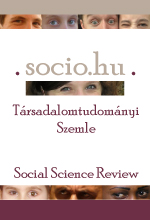Routes to right-wing extremism in times of crisis
Routes to right-wing extremism in times of crisis
An Austrian-Hungarian comparison based on the SOCRIS survey
Author(s): István Grajczjár, Zsófia Nagy, Antal Örkény, Julia HofmannSubject(s): Government/Political systems
Published by: MTA TK Szociológiai Intézet
Keywords: multiple crises; right-wing extremism; SOCRIS project; path-models; comaprative analysis in Austria and Hungary
Summary/Abstract: Right-wing extremism has been flourishing in many European countries since the outbreak of the financial crisis in 2008, and the migration wave of 2015 intensified right-wing extremist attitudes even more in several countries in the region. In this paper we analyse two countries impacted very differently by the financial and the refugee crises with the help of the 2017 SOCRIS survey, which investigated different forms of inclusive and exclusive solidarity in Austria and Hungary. This paper wishes to contribute to a better understanding of the growing popularity of right-wing extremism (FPÖ, JOBBIK and FIDESZ) in these countries. Using step by step linear regression models and path-model analyses we found that the popularity of FPÖ is due to a strong social disruption in Austria, which is primarily conspicuous in the area of political and social values. In Hungary, however, right-wing extremism is more widespread, but caused by a broader range of factors, since Fidesz and Jobbik fight for right-wing voters. Our results indicate that while right-wing extremist thinking was typical of well definable minority groups in Austria in 2017, there was a wide permeation of right-wing extremism among different social strata in Hungary.
Journal: Socio.hu Társadalomtudományi Szemle
- Issue Year: 8/2018
- Issue No: Spec 6
- Page Range: 95-117
- Page Count: 23
- Language: English

